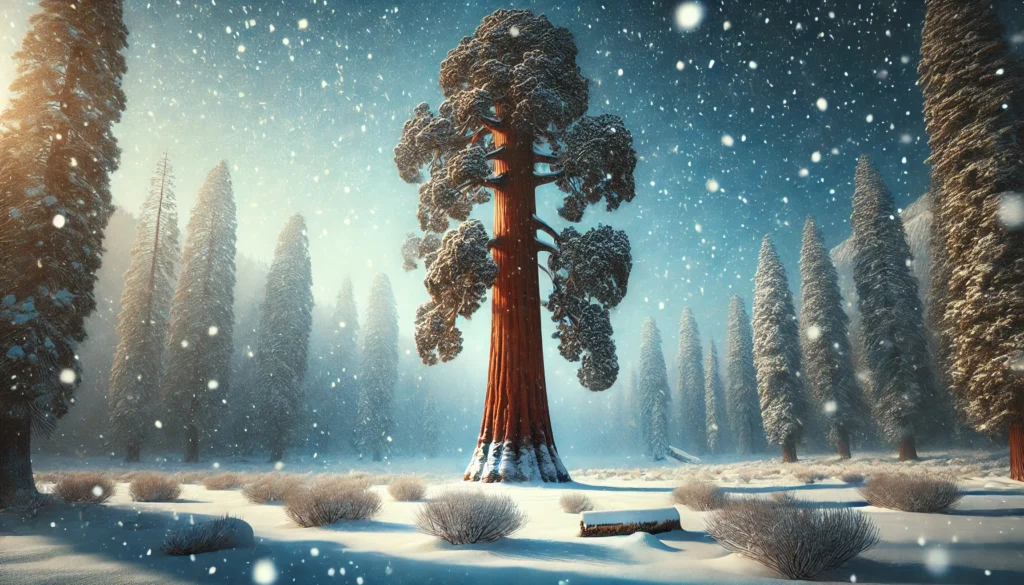
How Cold Hardy Are Sequoia Trees? A Complete Guide to Their Winter Survival
Sequoia trees are legendary for their massive size and awe-inspiring beauty 
Understanding the cold hardiness of Sequoia trees is crucial for ensuring their survival and long-term health in your landscape. In this guide, we’ll dive into exactly how cold Sequoia trees can handle, provide tips for winter protection, and explore ways to help your tree thrive during the colder months. By the end, you’ll have all the knowledge you need to keep your Sequoia tree safe, no matter where you live. Let’s get started!
Table of Contents
ToggleWhat Makes Sequoia Trees Unique in Cold Conditions? 

Sequoia trees are well-known for their massive size and majestic beauty, but how do they handle the harsh cold of winter? Let’s break down the unique qualities that help these giants thrive in cold conditions:
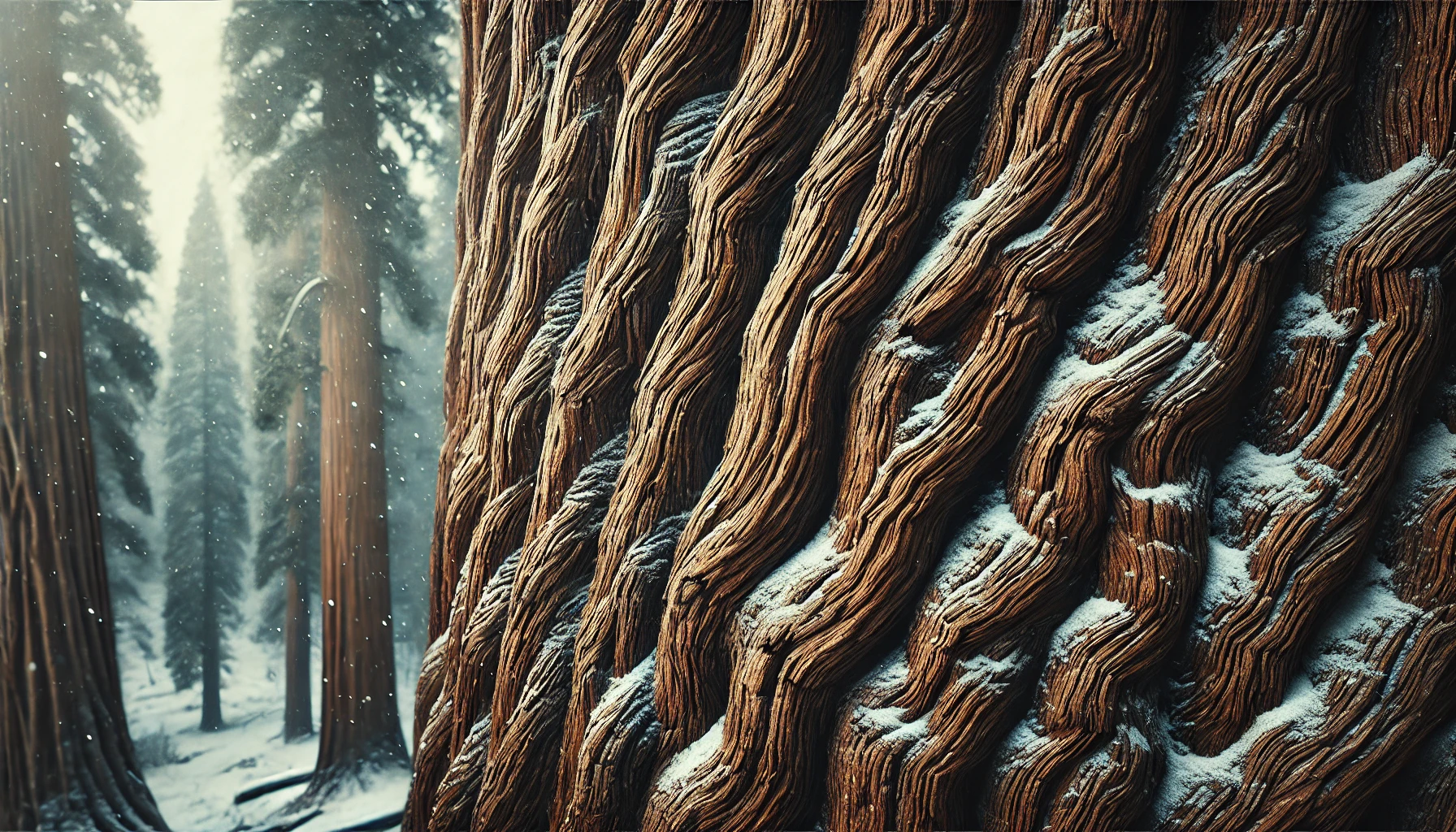
1. Thick Bark for Protection 
Sequoia trees have an extraordinary bark that can be over a foot thick! This bark acts as an insulating shield against extreme cold, preventing frost from penetrating deep into the tree. It’s a bit like wearing a cozy winter coat for these trees!
2. Evergreen Nature 
As evergreen trees, sequoias keep their needles year-round. Their needle-like leaves are specially designed to conserve moisture, which is especially important during the winter months when water may be scarce. This helps the tree maintain its health and continue to photosynthesize, even in the cold.
3. Root System Adaptation 
Sequoia trees develop deep, wide roots that anchor them firmly to the soil. This root system helps them access water stored deep below the surface, which is crucial in winter when the topsoil can freeze. They can continue to draw nutrients from the earth and stay hydrated, even when the surface is frozen solid.
4. Slow Growth in Winter 
During the colder months, sequoias slow down their growth. This natural winter dormancy helps them conserve energy and survive freezing temperatures without expending unnecessary resources. It’s like putting their growth on “pause” until the weather warms up!
5. Cold Tolerance and Adaptation 
Although sequoias are native to mild climates, they have adapted to withstand occasional cold snaps. Their cellular structure is built to endure freezing temperatures, and they can survive brief periods of snow and ice. However, prolonged exposure to extreme cold can still cause damage, so sequoias thrive best in areas with milder winters.
6. Protective Canopy 
The dense canopy of sequoia trees helps protect their lower branches and trunks from the worst of the cold. It acts as a natural blanket, keeping the core of the tree warmer during winter storms. This canopy can also shield smaller trees or plants beneath them from the chill.
Conclusion 
Sequoia trees are designed to survive cold conditions thanks to their thick bark, evergreen needles, deep roots, and cold tolerance. By understanding these unique features, we can better appreciate how these ancient giants continue to thrive in varied environments. Whether you’re planting one or simply admiring them, these trees are a stunning example of nature’s resilience in the face of winter’s harshest conditions!
Cold Hardiness of Sequoia Trees in Different Climates 

Sequoia trees, known for their towering height and impressive longevity, are native to the mild climates of California. However, their ability to survive in cold climates can be a concern for those looking to plant them outside their natural range. In this section, we’ll explore how cold hardy Sequoia trees are and offer tips for growing them in colder climates.

1. Cold Hardiness of Sequoias: What to Expect 
Sequoia trees (both Sequoia sempervirens and Sequoiadendron giganteum) are not the most cold-hardy trees. They thrive in USDA hardiness zones 7 to 9, where winters are relatively mild. While they can tolerate some frost, they struggle in temperatures that regularly dip below 20°F (-6°C). Extended cold spells can cause damage to the tree’s bark, roots, and even kill younger trees if they aren’t properly protected.
2. Sequoias in Cold Zones: Challenges and Solutions 
If you live in a region with harsh winters, you may be wondering if you can still grow Sequoia trees. While it’s a bit of a challenge, it’s not impossible. Here are some tips to help your Sequoia survive the cold:
- Choose the Right Variety: If you live in a colder climate, consider planting the Giant Sequoia (Sequoiadendron giganteum), which is more cold-tolerant than the Coast Redwood (Sequoia sempervirens). Giant Sequoias can survive temperatures as low as -10°F (-23°C) once they are well-established.
- Winter Protection: For younger trees, provide a layer of mulch around the base to insulate the roots and prevent freezing. You can also wrap the trunk with burlap to protect the bark from extreme cold.
- Plant in a Shelter: To help protect against freezing winds, plant Sequoias in a sheltered spot, such as near a fence, wall, or other large trees. This can provide natural windbreaks that shield them from the worst of the cold.
3. Ideal Growing Conditions for Sequoias 
To ensure your Sequoia thrives, it’s important to mimic the climate it naturally grows in. Here’s what to consider:
- Moisture: Sequoia trees need consistent moisture, especially in colder months. Make sure your tree has access to ample water throughout the year, even during winter when temperatures are low.
- Soil: Well-drained, sandy or loamy soils are ideal. Avoid heavy, waterlogged soils that can freeze and damage the roots.
- Sunlight: Sequoias love sunlight, so choose a planting location that gets at least 6 hours of direct sunlight each day.
4. Can Sequoia Trees Survive the Extreme Cold? 
If you’re located in an area where temperatures regularly fall below freezing, such as zones 4 or 5, growing Sequoia trees might be a struggle. While Giant Sequoias can survive brief cold snaps, they are unlikely to thrive in these colder zones over the long term. In extreme cases, the tree’s growth will slow, and its ability to produce new foliage could be hindered.
However, if you’re committed, you can grow Sequoia trees in pots and bring them indoors during the winter. This can give them the warmth they need while still allowing you to enjoy these majestic trees during the warmer months.
Conclusion 
While Sequoia trees are not the most cold-hardy species, there are ways to grow them successfully even in cooler climates. By choosing the right variety, providing winter protection, and creating an ideal environment, you can enjoy these iconic trees in your garden or landscape. Happy planting!
How to Protect Sequoia Trees in Cold Weather 

Sequoia trees, known for their massive size and impressive resilience, can still face challenges in colder temperatures. While they’re naturally adapted to thrive in temperate climates, protecting them during harsh winters is crucial for their health and growth. Here are some simple and effective ways to safeguard your sequoia trees in cold weather:
1. Mulch Around the Base 
Applying a thick layer of mulch around the base of your sequoia tree can be a game-changer during cold weather. Mulch acts as insulation, helping to maintain stable soil temperatures. This protection can prevent root damage from freezing and reduce the stress on your tree during sudden cold snaps. Use organic mulch like wood chips or shredded bark, and apply it in a 3-4 inch layer around the trunk, avoiding direct contact with the tree bark.
2. Wrap the Trunk 
Young or newly planted sequoias are particularly vulnerable to cold damage. Wrapping the trunk with tree wrap or burlap can shield it from frost and windburn. Make sure to cover the trunk from the base up to the first branches, securing it loosely to allow the tree to expand as it grows. This step can prevent cracks and splits that might occur due to freezing temperatures.
3. Provide Wind Protection 
Wind is often the biggest enemy of sequoias in cold weather. It can dry out the tree’s needles and sap, leading to stress and damage. If you live in an area with strong winter winds, consider installing windbreaks or barriers like fencing or tall shrubs around your tree. This will help buffer the sequoia from harsh winds and maintain a more stable microclimate.
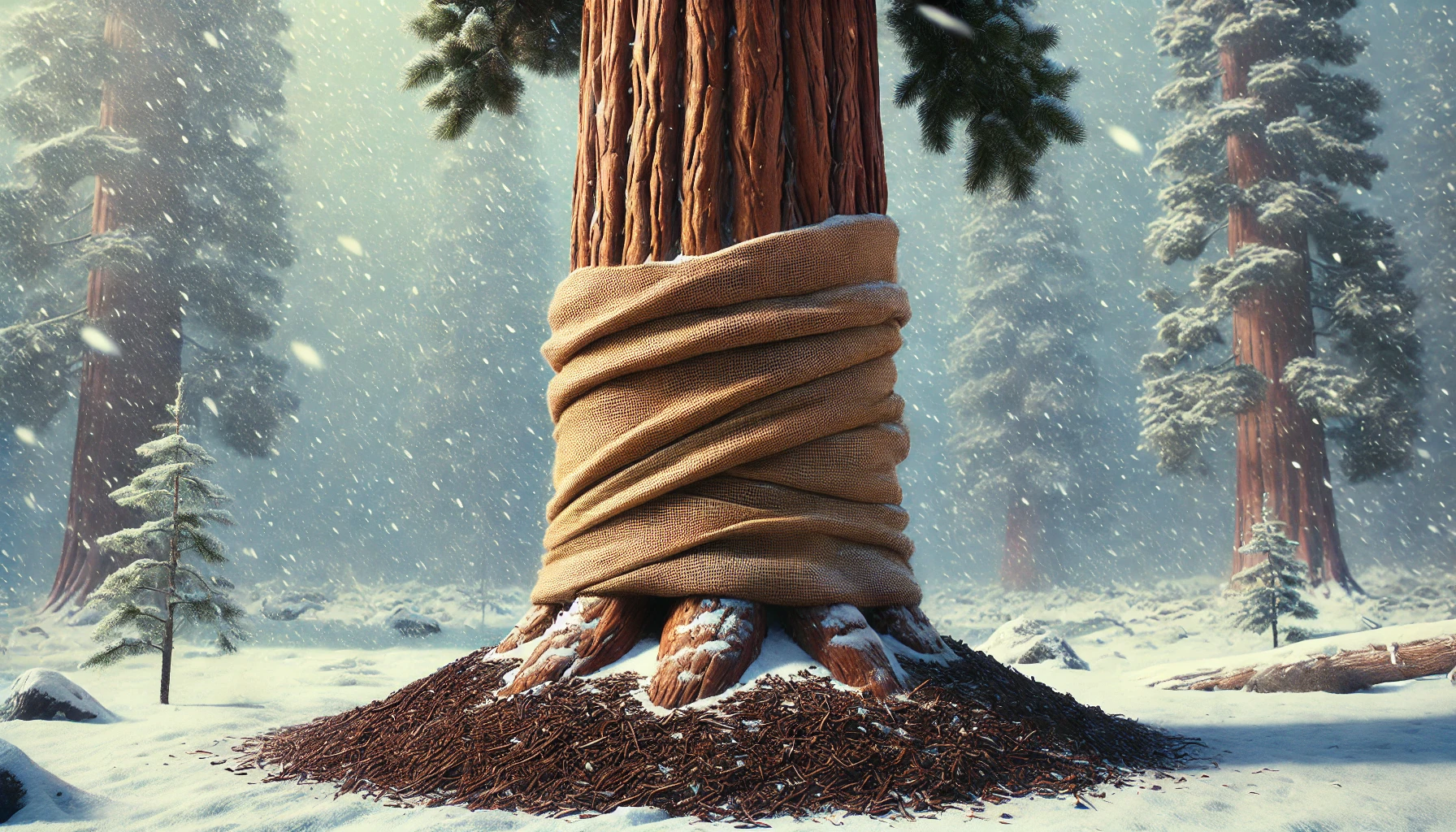
4. Water Properly 
Even in cold weather, it’s important to keep your sequoia hydrated. Watering your tree before the ground freezes helps it retain moisture throughout the winter. Ensure you water deeply and thoroughly in the fall to prepare your tree for the cold months ahead. Avoid watering when the ground is already frozen, as this can lead to root rot.
5. Prune Carefully 
Pruning can help your sequoia manage snow and ice loads more efficiently. Removing any dead or damaged branches reduces the risk of them breaking under the weight of snow or ice. However, be careful not to prune too much or at the wrong time of year—late winter or early spring is the best time to prune sequoias. Avoid pruning during cold spells when the tree is dormant.
6. Use Anti-Desiccant Sprays 
During extremely cold and windy winters, sequoia trees can lose moisture from their leaves (or needles). Applying an anti-desiccant spray, available at garden stores, creates a protective layer on the foliage that reduces moisture loss. This simple spray can help keep your sequoia’s needles from drying out and improve winter survival.
7. Monitor Temperature Extremes 
While sequoias are tough, extreme temperature shifts can still cause harm. Keep an eye on the forecast for any sudden drops in temperature, and be ready to take action if needed. Covering the tree with frost cloth during freezing nights can provide extra protection. Just remember to remove the covering once temperatures rise to avoid overheating.
8. Check for Pests 
Winter can bring out pests that target weakened trees. Keep an eye on your sequoia for any signs of pests like bark beetles or aphids. If you spot any, treat your tree with an appropriate pest control method, such as organic insecticidal soap or neem oil.
In Summary 
Protecting your sequoia trees in cold weather is all about preparing them for the harsh conditions ahead. By using mulch, wrapping trunks, providing wind protection, and ensuring proper watering, you can help your trees thrive through the winter months. With a little extra care, your sequoias will grow strong and healthy, ready to shine when warmer weather arrives!
Winter doesn’t have to be a worry for your sequoias—take these simple steps, and you’ll set your trees up for success all year long.
Common Cold-Weather Issues for Sequoia Trees 

While Sequoia trees are incredibly resilient, they’re not immune to the challenges that come with winter’s chill. Understanding these potential issues will help you better care for your tree and ensure it survives and thrives through the cold months. Here’s a quick look at the common cold-weather problems and how you can prevent or address them:
1. Frost Damage to New Growth 
Sequoias are most vulnerable to frost damage during early winter, particularly to any new growth that hasn’t fully hardened off. Young shoots or leaves exposed to sudden freezes can turn brown, shrivel, or die back.
Tip: Protect tender new growth by wrapping your tree with burlap or using frost cloth if you’re expecting cold snaps. Keep an eye on early frost warnings to act quickly!
2. Root Freeze 
Sequoia trees have deep, expansive root systems, but that doesn’t mean they’re safe from freezing. In particularly harsh winters, the ground can freeze deep enough to damage the roots, leading to reduced nutrient uptake and poor tree health in the spring.
Tip: Mulch around the base of your Sequoia to insulate the roots. A thick layer of mulch can keep the soil warmer and protect the roots from freezing. Make sure to leave space around the trunk to avoid moisture buildup.
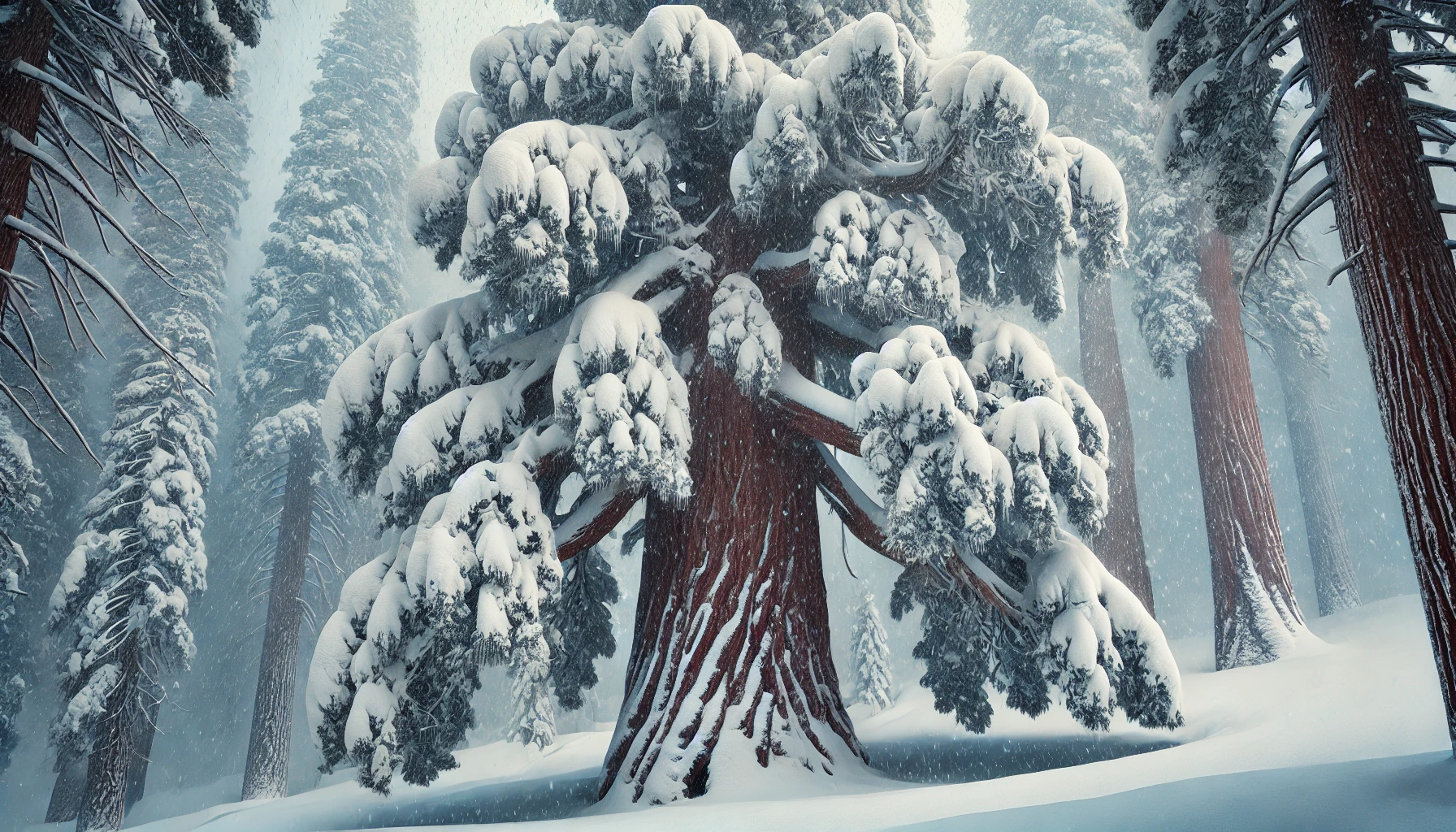
3. Snow and Ice Load on Branches 
Heavy snow or ice accumulation on the branches of Sequoias can cause breakage or damage, especially if the weight is concentrated on the tree’s outer limbs. While Sequoias have strong wood, their dense, wide branches can be susceptible to the added weight.
Tip: If you’re in a region with heavy snow, gently shake off any snow or ice that accumulates on your tree’s branches. Do this carefully to avoid snapping any twigs. For very heavy snowfalls, consider using a light, non-invasive tree prop.
4. Winter Sunscald 
During winter, Sequoias, like many evergreen trees, can suffer from sunscald when the tree’s bark warms up on sunny days and then rapidly cools at night. This fluctuation can crack and damage the bark, making the tree vulnerable to disease.
Tip: Wrap the trunk of younger Sequoias with tree wrap or burlap during winter. This protects the bark from extreme temperature shifts and keeps the tree’s protective outer layer intact.
5. Water Stress 
Even in cold months, Sequoia trees still need adequate water. If the ground is frozen, their roots can’t absorb moisture, leaving the tree dehydrated. This can weaken the tree and make it more vulnerable to other winter stresses.
Tip: Water your Sequoia thoroughly before the first hard freeze. Once the soil thaws in the spring, be sure to continue providing regular watering, especially if it’s a dry season.
6. Pests Seeking Shelter 
Cold weather drives some pests, like bark beetles, to seek shelter in the warm, protected areas of trees. Sequoias, especially older ones, can attract these pests during winter months, which may lead to bark damage or disease.
Tip: Regularly inspect your Sequoia for signs of pest activity. If you notice holes in the bark or sawdust-like material, consider contacting a tree care professional to treat the tree before the pests can cause serious harm.
7. Wind Damage 
Winter storms often bring high winds, which can topple trees or cause significant damage to their branches. Sequoias, with their tall stature and flexible branches, are particularly vulnerable to strong gusts.
Tip: If you live in a wind-prone area, ensure your Sequoia is properly anchored in the ground. If your tree is young, you might want to stake it gently to prevent wind damage.
By understanding and addressing these common cold-weather issues, you can help your Sequoia tree weather the winter with ease. A little preparation goes a long way in ensuring that your majestic tree remains healthy and strong year after year!
The Best Zones for Planting Sequoia Trees and Winter Survival Tips 

Sequoia trees, known for their towering height and majestic presence, are stunning additions to any landscape. But, like all plants, they have specific needs when it comes to climate. If you’re thinking of planting a Sequoia, understanding the best zones for them and how to help them survive winter is key to ensuring their long-term health and growth. Let’s dive into the best zones and share some tips for winter survival!
 Best Zones for Planting Sequoia Trees
Best Zones for Planting Sequoia Trees
Sequoia trees thrive in USDA Hardiness Zones 6-8, though they can tolerate slightly cooler or warmer climates with the right care. These zones generally cover regions with mild winters and moderate summers—perfect for Sequoias to grow into the giants they’re meant to be.
- Zone 6 (Avg. Winter Low: -10 to 0°F or -23 to -18°C): Sequoias can tolerate light frost and some colder temperatures, especially if given extra protection during harsh winters.
- Zone 7 (Avg. Winter Low: 0 to 10°F or -18 to -12°C): This is the sweet spot for Sequoias. They thrive in moderate winters and well-drained soil.
- Zone 8 (Avg. Winter Low: 10 to 20°F or -12 to -6°C): While Sequoias can grow here, you’ll need to ensure they have access to plenty of water and some shade in the heat of summer.
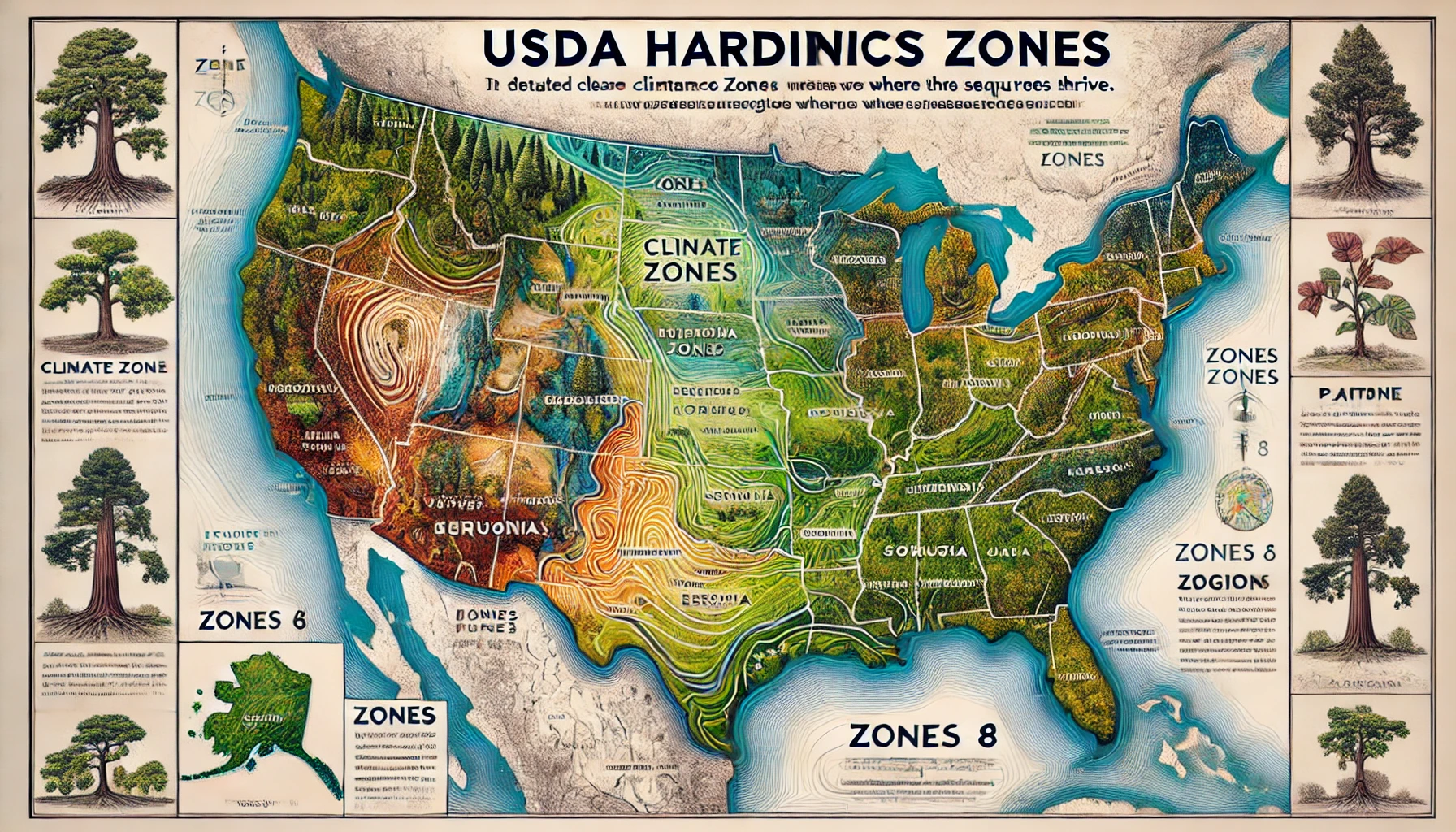
If you’re outside of these zones, don’t worry—Sequoias can still grow in colder or warmer climates with a bit more attention. But be sure to give them the right environment to prevent winter damage.
 Winter Survival Tips for Sequoia Trees
Winter Survival Tips for Sequoia Trees
Winter can be a tough season for trees, but Sequoias are resilient. Here are some easy-to-follow tips to help your Sequoia survive and thrive through the cold months:
- Mulch for Protection
Apply a thick layer of mulch around the base of your Sequoia tree. Mulch helps insulate the roots, prevents frost from penetrating the soil, and retains moisture. Aim for 3–5 inches of mulch, but keep it away from the trunk to avoid rot. - Watering During Winter
While Sequoias are fairly drought-tolerant, they still need water during dry winter months. Deep watering before the first frost can help your tree store moisture and survive cold spells. Make sure the soil isn’t too soggy, as waterlogged roots can lead to root rot. - Protection from Wind
Cold winds can damage your Sequoia’s needles and bark. Consider planting your Sequoia in a sheltered area, or use a windbreak (such as a fence or hedge) to reduce exposure to harsh winds. This helps protect the tree from drying out or experiencing damage. - Snow and Ice Care
If heavy snow or ice accumulates on the branches of your Sequoia, gently brush it off to prevent the branches from snapping. However, don’t use sharp objects or excessive force—be gentle! Over time, ice can cause permanent damage to the tree. - Frost Cloths and Covers
For young or newly planted Sequoias, you may want to cover them with frost cloth during extreme cold spells. These covers provide a barrier against frost and help trap warmth around the tree. Just make sure to remove the covers once the danger of frost has passed. - Monitor for Pests and Disease
During the winter months, pests like aphids or fungi can still affect your Sequoia. Keep an eye on your tree for any unusual spots, holes, or pests. Treat with organic insecticides or fungicides if necessary to prevent winter infections.
 Final Thoughts
Final Thoughts
Planting a Sequoia tree in the right zone and providing it with the proper winter care will ensure that it grows into a beautiful, healthy tree. Keep an eye on the weather, protect your tree from extreme conditions, and give it plenty of water and mulch. With these tips, your Sequoia will be ready to survive the winter and thrive for many years to come!
Happy planting, and enjoy watching your Sequoia grow!
Conclusion
Sequoia trees, though majestic and resilient, do require a bit of attention when winter arrives. By understanding how cold-hardy Sequoia trees are and taking the right steps to protect them, you can ensure that these towering giants survive and thrive through even the coldest months. From mulching to proper watering and using protective coverings, your Sequoia will have a much better chance of withstanding harsh winter conditions.
Remember, preparing your Sequoia for winter is an investment in its long-term health. Whether you’re planting in a cold climate or protecting a mature tree, the effort you put into winterizing now will pay off with a stronger, healthier tree come spring.

Final Tips:
- Focus on proper drainage and mulching to protect roots.
- Use burlap or frost blankets for extra protection during extreme cold.
- Ensure deep watering before the ground freezes to keep your tree hydrated.
By taking these simple yet crucial steps, you’ll be setting your Sequoia tree up for success and ensuring it grows into the majestic beauty it’s meant to be—no matter what the winter throws its way.
Call to Action:
Start winterizing your Sequoia today and enjoy the peace of mind knowing your tree is ready to face the cold with confidence. Happy planting and protecting!
Frequently Asked Questions(FAQ)
How cold-hardy are Sequoia trees?
Sequoia trees are cold-hardy to USDA Zone 6, with some varieties (like Giant Sequoia) capable of tolerating temperatures as low as -10°F (-23°C). However, their cold tolerance can vary depending on age and environmental conditions, so they may need extra protection in regions with harsher winters.
Can Sequoia trees survive freezing temperatures?
Yes, Sequoia trees can survive freezing temperatures, but they need proper care to ensure they withstand extreme cold. Protecting young trees with burlap, mulching around the base, and providing adequate watering before the ground freezes are all important steps to help them endure freezing weather.
What is the best way to protect Sequoia trees during winter?
To protect Sequoia trees during winter, apply a layer of mulch around the base to insulate the roots, wrap young trees with burlap to shield them from cold winds, and ensure deep watering before the ground freezes to keep them hydrated. Additionally, creating windbreaks can help minimize frost damage.
IAre Giant Sequoias more cold-hardy than Coast Redwoods?
Yes, Giant Sequoias (Sequoiadendron giganteum) are generally more cold-hardy than Coast Redwoods (Sequoia sempervirens). Giant Sequoias can tolerate temperatures as low as -10°F, while Coast Redwoods are typically more suited for milder climates (Zones 7 and above) and are less frost-tolerant
How do I know if my Sequoia tree is at risk of frost damage?
Signs that your Sequoia tree may be at risk of frost damage include yellowing or browning needles, especially on the outer branches. If the tree has stunted growth or the needles appear dry or scorched, it may indicate frost or wind damage. Address these issues with proper winter care, such as wrapping and mulching.
Can Sequoia trees survive in extremely cold climates?
While Sequoia trees are not ideal for extremely cold climates (below USDA Zone 6), they can survive in cold regions with proper winterization. In harsher climates, planting near a building for added warmth or using frost covers can help protect them from extreme winter conditions.
Do I need to water my Sequoia tree during the winter?
Yes, it’s important to water your Sequoia tree before the ground freezes to ensure the roots are hydrated. However, you should reduce watering during the winter months to prevent waterlogging and root rot. Always make sure the soil drains well and doesn’t stay too soggy during cold spells.
Can Sequoia trees handle heavy snow and ice?
Sequoia trees can generally handle some snow and ice, but heavy accumulation on branches can cause breakage. To prevent damage, gently brush snow off the branches during a snowstorm. Additionally, providing wind protection and ensuring proper care will help minimize the risk of ice and snow-related damage.










